Research Methods in Cognitive Psychology Pdf
Today in this article we will give you info about the topic Research Methods in Cognitive Psychology Pdf (PET fMRI ERP) and this article focuses on the research methods in Cognitive Psychology in the first part and methods in Cognitive Neuroscience in the latter part. We will talk about reaction time (RT) studies and various factors that influence reaction time. In the Cognitive Neuroscience part, we will focus on research methods used to investigate functional and neural correlates of mental functions, viz., localization of mental functions by using various brain imaging techniques (PET and fMRI Scan, etc. ) and ERP System studies.
In the last article, I talked to you about the basics of research methods in psychology that was more to give you a background on what kind of research designs what kind of research questions, and what is the general method of conducting research in psychology in today’s article I will talk to you more specifically about the kind of methods that have been used in cognitive psychology to conduct different kinds of experiments.
What do we already know what the basic research methods?
the basic kind of research design in psychology knows that there are three types of designs-
- Descriptive
- Correlational
- Experimental
In research design, we also know that the emphasis basically in research in psychology is to be able to quantify aspects of behavior in a way that they can be empirically measured only then we can actually make scientific claims.
Methods in Cognitive Psychology
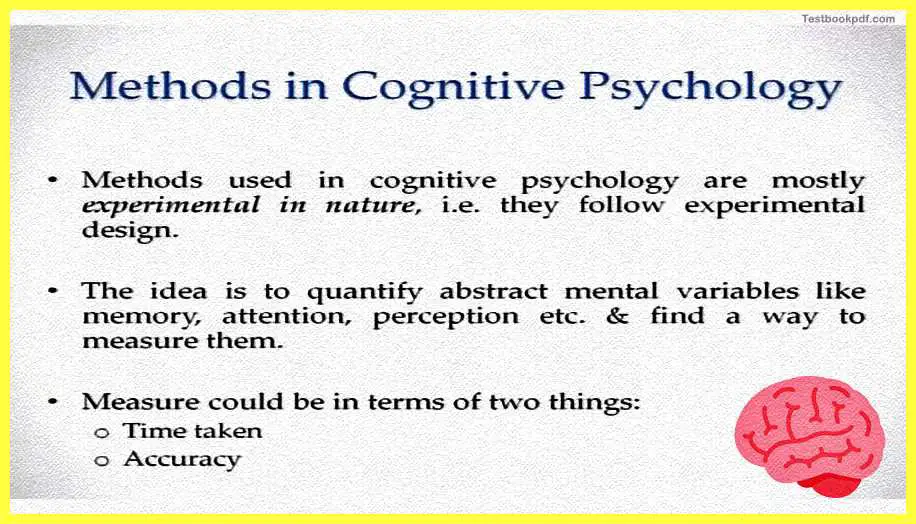
About particular behavioral phenomena we also in the last section of the last article talked about aspects of reliability and validity of research findings now that is a very important factor which ensures that whether your research is dependable or not whether you are actually getting anywhere close to answering your questions and answering them correctly, let us now talk about methods which are used in cognitive psychology specifically methods in cognitive psychology more or less are experimental in nature.
So generally we are actually into experiments and we are asking if we are following the experimental research design that is to say we kind of are always interested in manipulating certain variables and testing the effects of this manipulation on certain other variables what are the variables in cognitive psychology variables in cognitive psychology basically are those abstract mental phenomena which we try and quantify and then we try and investigate them by studying the effects of different things on these mental phenomena or say for example studying the effects of various mental phenomena on some other related or unrelated mental phenomena say for example how does attention influence perception say for example how does a stimulus size or a number of stimuli or type of stimuli affect your visual search performance or it affects your recall of items these are the kind of questions that are generally asked in cognitive psychology.
Now, what are the kind of measures that we do generally in cognitive psychology we are measuring stuff in terms of the time taken to process a particular thing or how accurately you process that thing so these are the two dependent variables these are to do dependent measures about the dependent variable which we are actually taking into account now one of the most foremost methods in cognitive psychology is mental chronometry?
What is mental Chronometry?
Mental chronometry basically is the use of response time in perceptual-motor tasks to infer the content the duration and the temporal sequencing of mental or cognitive operations now what am I trying to say here I am trying to say that we assume that a particular behavioral response is basically it has in background different mental operations now we really want to check how those mental operations are done.
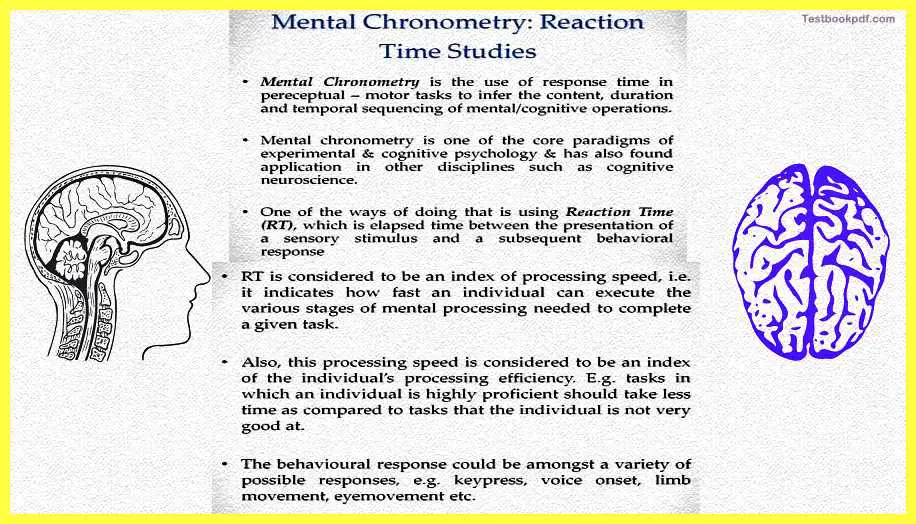
So what is the time taken say for example if I just ask you to compare two numbers how do you add the two numbers or how do you do this comparison basically what are the effects how do you evoke the representation of the number how do you then compare it and how do you decide to tell me whether one of the numbers is larger or smaller than the other these are different sets of mental operations that might underlie your simple response of just pressing a button to tell me whether number a or b is larger these is basically done through this is basically the idea behind.
What is mental chronometry?
mental chronometry is one of the most important and core paradigms in experimental cognitive psychology and it is also found used in other disciplines such as cognitive neuroscience.
We’ll talk about that in a while one of the easiest ways of doing mental chronometry or using mental chronometry is to measure reaction time.
What is the reaction time?
reaction time simply is the elapsed time between the presentation of a particular kind of stimuli and the appearance of a subsequent behavioral response so if I for example show you a particular number and if i just ask you to tell me whether it is a number or just a shape the time elapsed between the presentation of that stimulus on the screen and the time you take to actually press a button and tell me whether it was a number or a shape is your reaction time.
Reaction times are considered to be an index of processing speed and how fast you did those processes, it indicates how fast an individual can execute the various stages of mental processing needed to complete a given task say for example the task I give you is to compare two numbers also this processing speed tells us something about an individual’s processing efficiency things that an individual is very good at should take lesser time things that the individual is not very good at should take more time it is a simple reduction that can be made now there could be a variety of behavioral responses that one could take in these reaction time studies it could either be a simple key press response press yes press y for yes.
and for no, it could be a voice onset you ask people to name particular pictures and you record their voice onset time another could be limb movements you ask them to wave their hands or move their legs something like that or it could be simply eye movement say for example if you want to ask the person to move their eyes from a point a to point b during a particular experiment depending the choice of what kind of measure you are actually going to use in a particular study depends mostly on the kind of research question that you fast.
Types of Reaction Time (RT) Tasks
now let us talk about different types of reaction time tasks now one of the first persons who ever used the reaction time task was Franciscus Donders, now Donders was a dutch physiologist who in 1868 was interested in determining how long it too for a person to take a decision he basically conducted one of the first experiments that can be considered to be an experiment in cognitive psychology.
So how did he do this?
He basically determined this by measuring the reaction time which is how long it to his participants to respond to the presentation of a kind of stimulus.
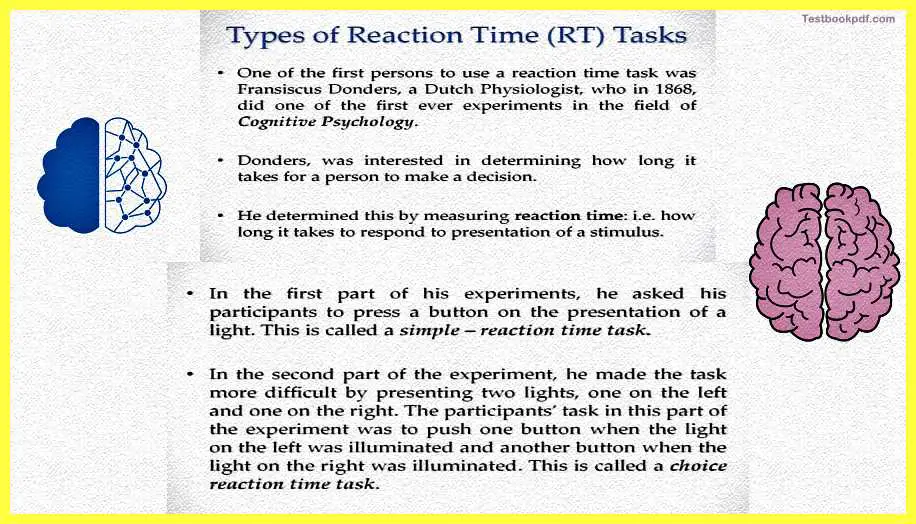
Let us go further and in the first kind of his experiment, Donders basically presented his participants just with the dot and asked them to press a button on the presentation of this dot it was a dot of light on a particular kind of screen now this kind of task was termed as the very simple reaction time task where you just have to see whether the dot is there and you have to press a particular button in the other part of his experiment what don just did was he made the task slightly more difficult he presented now one dot to the left side of the screen and another dot to the right side of the screen he now asks this participant to press the button A when he when the light on the left side was lit up and button b when the light on the right side was lit up now this you can see is a systematically more difficult task than the earlier simple reaction time task we were talking about.
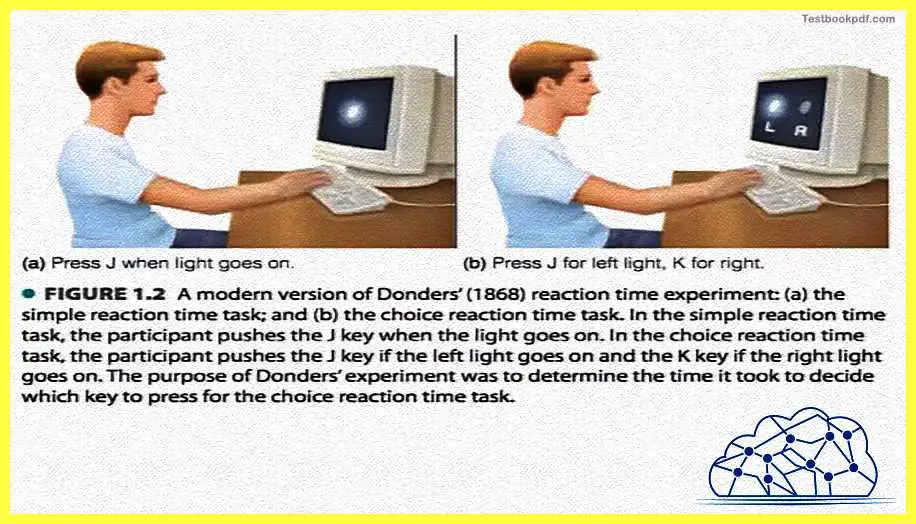
Here you can see the setup for these kinds of tasks in the figure you can see that the instruction is just to press a light when just to press a key j when the light goes on and in the second setup you can see that the participant has been asked to press j for left right left light and k for the right line so in that sense systematically there is more effort or more mental processes are there.
Let us move into how the comparison of these two tasks are Donders reason that the choice reaction time task would take longer than the simple reaction time task because the additional time it takes to make the decision you have to see where the light came from and then you have to decide which of the buttons you are going to press.
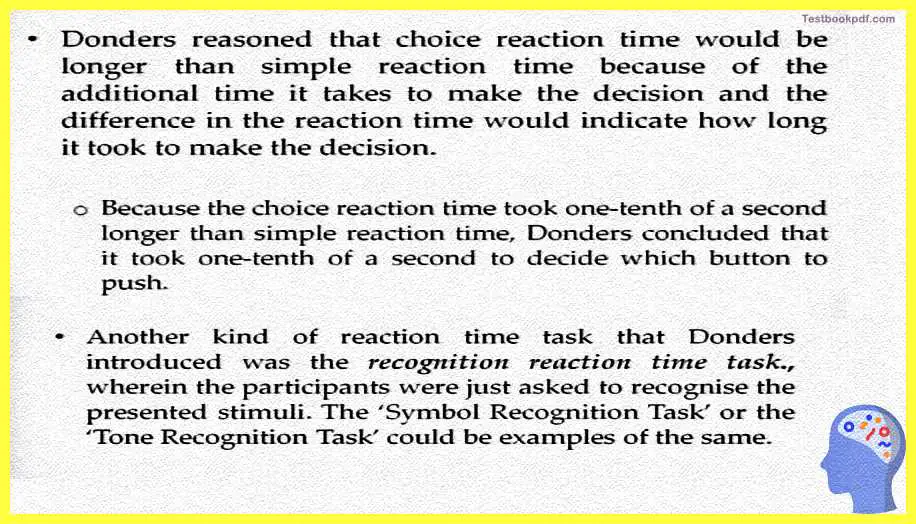
That is why he basically thought that the choice reaction time task will take more time than the simple reaction time task and now if you subtract the simple reaction time task from the choice reaction time you will get a number that will actually tell you how much time it to decide which key was supposed to be placed this is a simple subtraction technique that Donders used and in that sense, he actually talked about how you can really calculate the amount of time that is taken in each step of a particular mental process.
So Donders in that sense in this example found out that the choice reaction time task to one-tenth of a second or let us say 100 milliseconds longer than the simple reaction time task and very easily through subtraction he could actually tell that the decision to decide the decision to about which button was to be pressed to about 100 milliseconds.
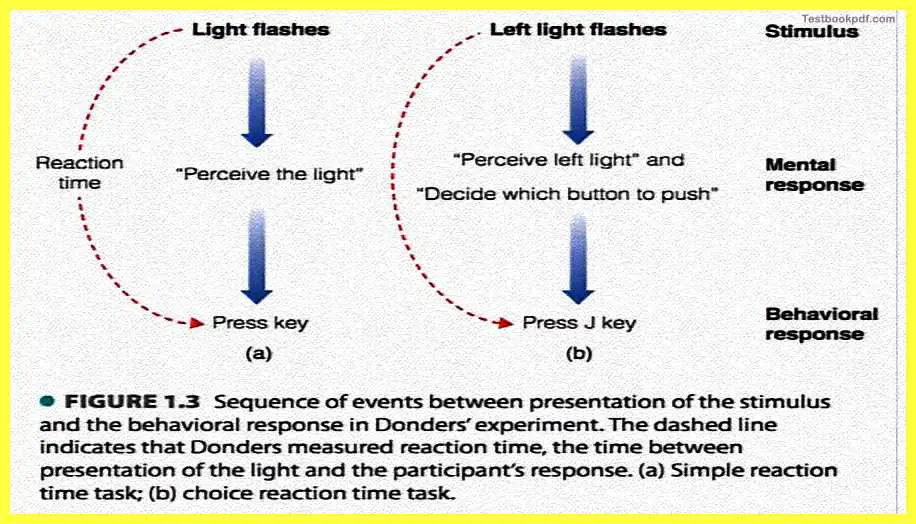
Here is a kind of graphical representation of what might have gone on in those tasks you can see that when the light when in the simple reaction time task in the panel light flashes you perceive the light and you simply press the key on the panel b a particular side left or right light flashes you perceive the light but you then have to decide which button is going to be pressed whether j or k then you press the j key because the left light has been presented in that sense you can already see that there was a step added and that is what actually to the made the participant to a slightly longer time.
Now another kind of reaction time task that Donders introduced was the recognition reaction time task in this kind of task the participants were asked to basically recognize the kind of stimulus presented if you see in the simple reaction time task they were just asked to press a key when a particular stimulus was detected here they were asked to determine what that stimulus was said, for example, to determine whether a particular symbol was presented let us say if I just ask you to determine k among the set of different letters that is an example of a symbol recognition task this task is slightly more difficult than the simple reaction time task.
Let us talk to talk to you about a bit of other but if other factors about reaction time studies so there is some knowledge which is been there say for example the mean reaction times for light stimuli is generally around 190 milliseconds mean reaction times for sound stimuli is generally about 160 milliseconds Donders showed that the simple reaction time task a simple reaction time is shorter than the recognition reaction time which in turn is shorter than the choice reaction time.
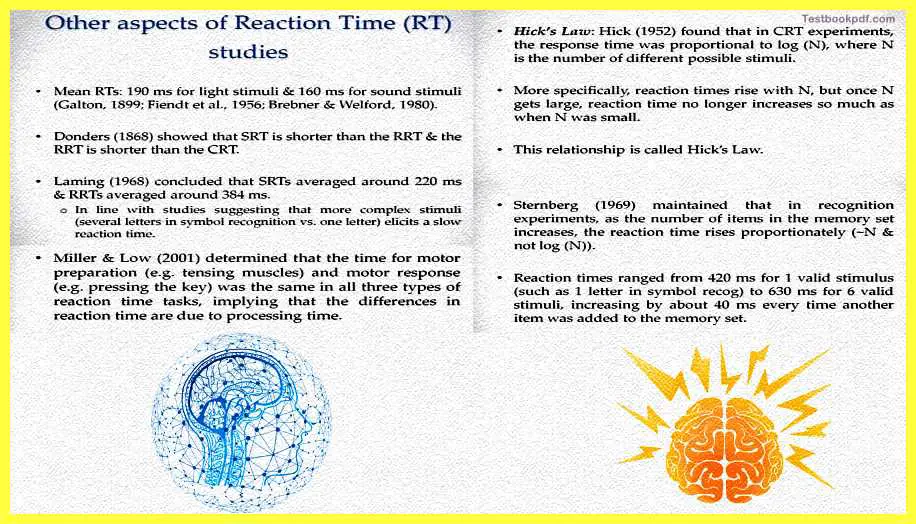
So choice reaction time in that sense is the most difficult of the three kinds of reaction time tasks lemming 1968 concluded that simple reaction times generally average around 220 milliseconds whereas recognition reaction times generally measured around 4,384 milliseconds this was in line with studies that suggested that more complex stimuli say for example several letters you actually need to see a panel of several letters among which you will recognize one letter during a recognition reaction time elicit a slow reaction time so this is something which is already found out.
Miller and low 2001 determined that the time for motor preparation so you have to prepare your hand for actually being able to press the button, the motor that will lead to a particular kind of tensing of muscles and the motor response when you finally press the key was generally same in all the three kinds of reaction time task in the simple reaction time task in the recognition reaction time task and in the choice reaction time task which led him to which led the authors to conclude that the differences among these kinds of on in these tasks the simple reaction time the recognition reaction time and the choice action time is basically only due to processing time because.
There is a stage added each time you actually change the task now an interesting finding about choice reaction time experiments is that the response time is proportional to the log of n where n is the number of stimuli in question so the number of stimuli that you present more specifically you can say that reaction times generally rise within if you have more stimuli the reaction time will rise to a particular point but after n or the number of signaling gets sufficiently large then the reaction time does not increase anymore so this kind of relationship between the number of stimuli and the reaction time was called the hick’s law.
Sternberg in 1969 maintained that in a recognition experiment in terms of a recognition reaction time task the number of items in the memory set increases the reaction time then increases proportionately so he said that reaction times are proportional to n and not the log of n in case of a recognition reaction time or in case of a recognition experiment he actually showed.
Participants measured reaction times for participants for one valid stimulus in a panel stimulus compared to six valid stimuli and they found that reaction time was around 420 milliseconds for one valid stimulus in the rit task and 630 milliseconds for a valid uh stimuli in our data so basically the reaction times were increasing by almost 40 milliseconds every time you increase the number of stimuli in the set.
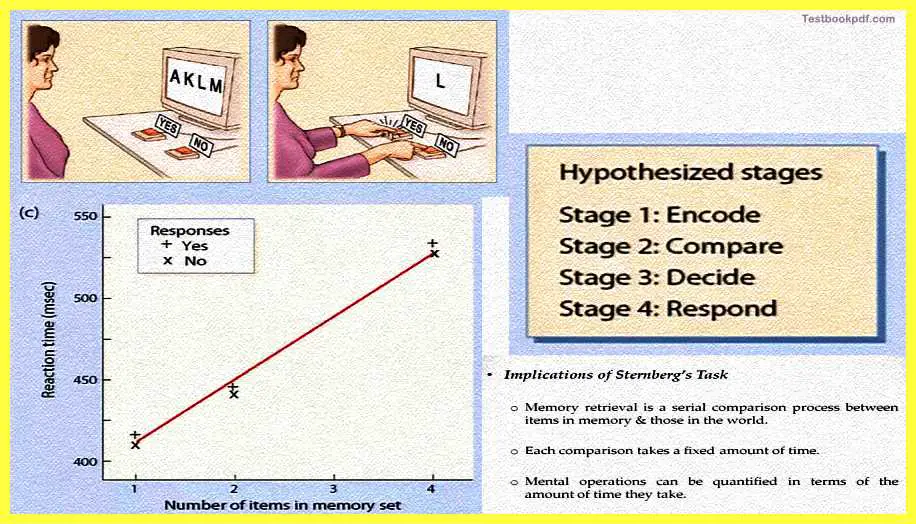
So, this is a setup say for example you have to just recognize l in the panel of four letters versus if you have to recognize L in a panel of six or seven letters something like that so what he basically thought was that these were the stages in doing this we have a stage of encoding what is the stimuli presented comparing that whether there is L or not in therein and then decide which button to push and those kinds of thing and then finally responding so you showed here you can see that the number of items in the memory set and the reaction times are actually related in a positively in that sense the they are directly proportional to each other.
Now what kind of implications can be drawn from stern works task at least one that memory retrieval is a serial comparison process so for example that is why the number of items you raise it kind of serially or linearly it increases your reaction time second is each of these comparisons takes a fixed amount of time.
So for example one comparison generally should take around 40 milliseconds that is why the amount of reaction time increasing with each adding stimuli was around 40 milliseconds now mental operations I mean overall something which actually comes out from Sternberg’s task is that mental operations can actually be successfully quantified in terms of amounts of time they take so the stage takes that a particular stage takes a particular amount of time was validated in some sense in this kind of a study.
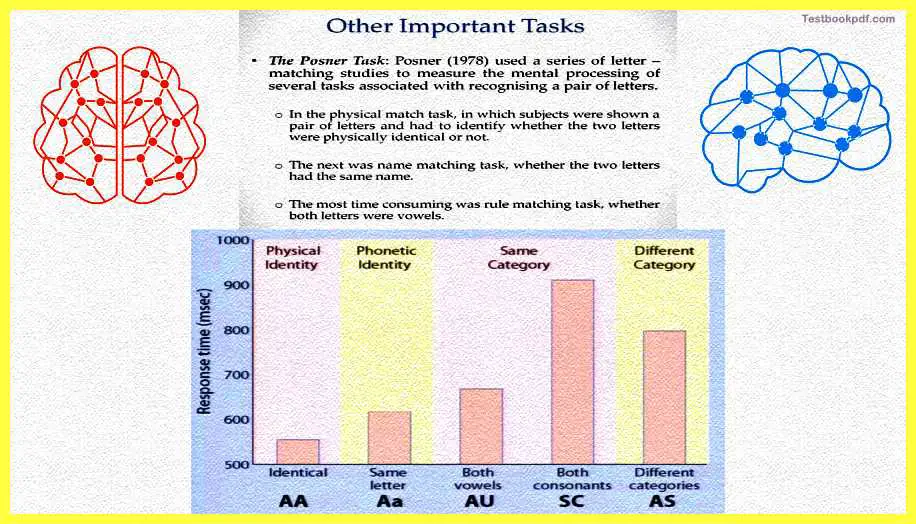
Now coming to some other important reaction time studies of the past so one of the more important studies was done by Posner mike in 1978 he basically used a series of letter matching tasks to measure the mental processing of several tasks associated with recognizing a pair of letters so he had a physical matching task in which the subjects were just shown a pair of letters and they had to identify whether they were identical or not in a second name matching task they had to just tell whether they were the same ident same letters or not whether they had the same name or not and in the third or the other kind of task was that whether they were wobbling whether they belong to the same category according to a rule or not so whether they are both vowels or both consonants.
Here is the setup so you can see the lowest reaction time is taken in physical identity say for example both are is the slightly more time is spent while you have asked the phonetic identity is a small a or a capital a third is whether they are both vowels or not so you see that the reaction time increases linearly here so this is one of the ways.
Basically, this tells us again confirms the findings which we actually drew from the earlier Sternberg task another important task was jazz troops James ridley’s troops Stroop task which basically wherein he asked participants to read out names of color words so you can talk about red green blue orange etcetera but they were printed in an ink color which could be either congruent to the color word say for example red is presented in red ink or it could not so red is presented with greening something like that he found out was what he found out was that participants performed verse when there was no match between the color word and the color ink and it also tells us that multiple kinds of representations can get activated when you are looking at a particular song so you just see it these are the kind of stimuli that were used so for example red is presented in red ink.

Whereas red is presented in blue ink or say what is the green is presented in green ink or green is recommended red ink so these are the kind of stimuli that were used.
This is what the performance of arsenals could be like so you are actually seeing green written but it is presented in green ink so you actually have to just name the color of the ink so that is what is leading to this conflict.
So these are the three very basic kinds of reaction time tasks that have been very important over the years and have guided a lot many reaction time studies what would be the other factors that could influence reaction time at least two of them I will mention here.
For example, it is known that reaction time to sound is much faster than reaction time to light say for example the reaction times of sound are generally around 140 to 160 milliseconds reaction to visual stimuli is somewhere between 180 to 200 milliseconds also Freeburg found out that visual stimuli that are presented for longer durations elicit faster reaction times because it’s got more time to process let us say and wells found the same finding for auditory stimuli so this is so much about the reaction time studies reaction time.
Factors Influencing RTs
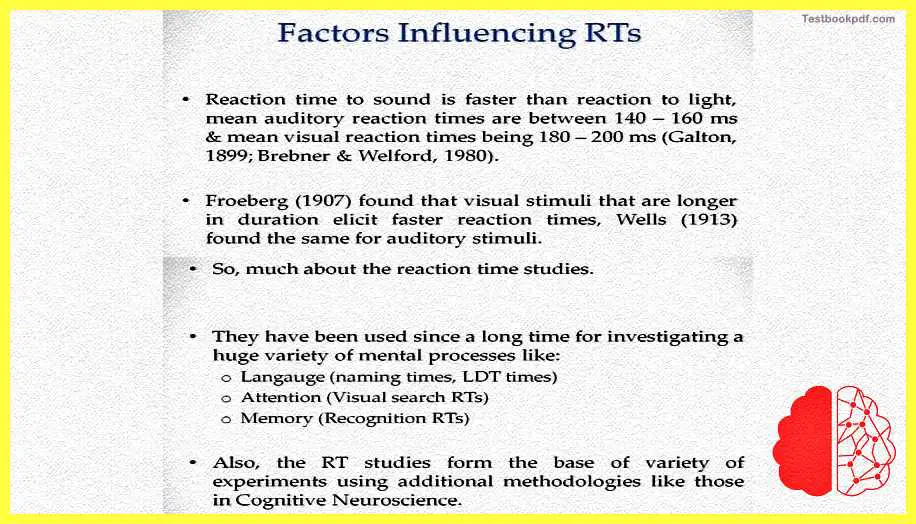
Study a variety of mental phenomena say for example perception and combination of language using naming times when you actually see a picture and you name it you read a word and you name it lexical decision times whether a word whether the presented stimulus is a valid word or not a valid word uh attention say for example visual, visual search kind of a paradigm so you’re given a scenario when you have to do for the red x in a number of o’s or else something like that also a memory say for example you are asked to recognize whether a particular shape was presented in one of the earlier trials or not something like that.
We will talk about this in much more detail when you are actually discussing these different cognitive functions and discussing the kind of experiments that have been used to study them now, the reaction time studies actually have also found has formed the base of the variety of experiments which are used in additional methodologies like FMRI, etc in fields like cognitive neuroscience now cognitive neuroscience basically let us talk about what kind of methods are used in cognitive neuroscience.
Methods in Cognitive Neuroscience
Now one of the most important concerns of cognitive neuroscience is basically localizing the function so the whole idea is that experimental designs in cognitive neuroscience are designed are basically intended to let us know or to study whether a particular cognitive function can be reliably associated with a particular structural region of the brain.
So, that is why most of the methodologies used in cognitive neuroscience are actually designed to do just that.
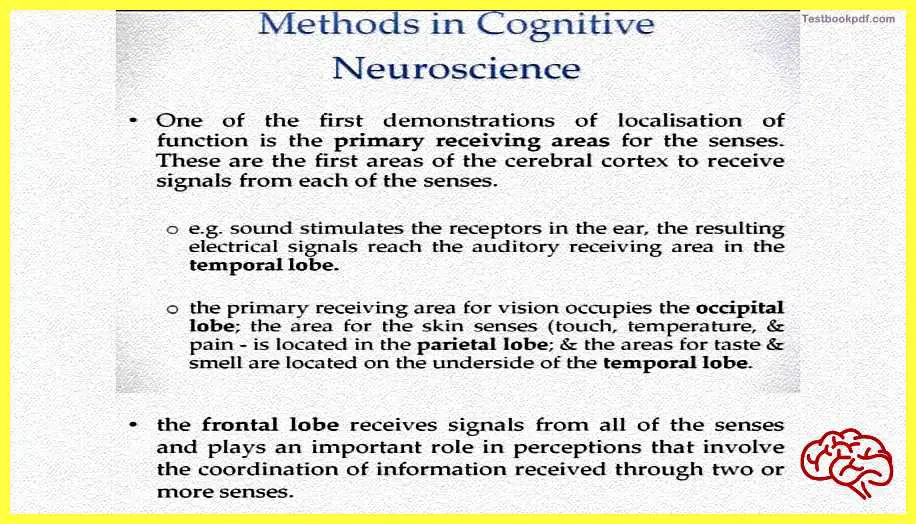
now one of the first demonstrations of the localization of function basically comes as the demonstration of primary receiving areas for the senses primary receiving areas basically are the first areas of the cerebral cortex to receive signals from each of the senses if you remember we were talking about this in our articles on cognitive neuroscience now, for example, sound, sound stimulates the receptors in the ear and these receptors basically send electrical signals to the auditory receiving area which is there in the temporal lobe of the brain so that kind of relationship has been made similarly the primary receiving area for vision information or visual information occupies the occipital lobe so that is where the all the information from the eyes goes to where in this basic or initial visual processing takes place similarly the area for skin senses which is touch temperature pressure pain that kind of things is basically done first in the areas located in the parietal lobe.
So here you can see that these are specific areas are processing these are specific areas of the brain which are processing specific kinds of input that our body receives we see something we hear something we touch something those kinds of things areas, where taste and smell are located under the temporal lobe.
What does the frontal lobe do?
The frontal lobe basically receives signals from all of these senses and it actually plays a very important role in perceptions that involve the coordination of information which is reaching through a variety of senses say for example on the basis of sights and smells of a place you might need to decide whether you want to stay in that place for a longer time or you want to just move out of that place this kind of decision making is actually done in the frontal lobes wherein they are actually evaluating a different kind of sensory input that you are getting.
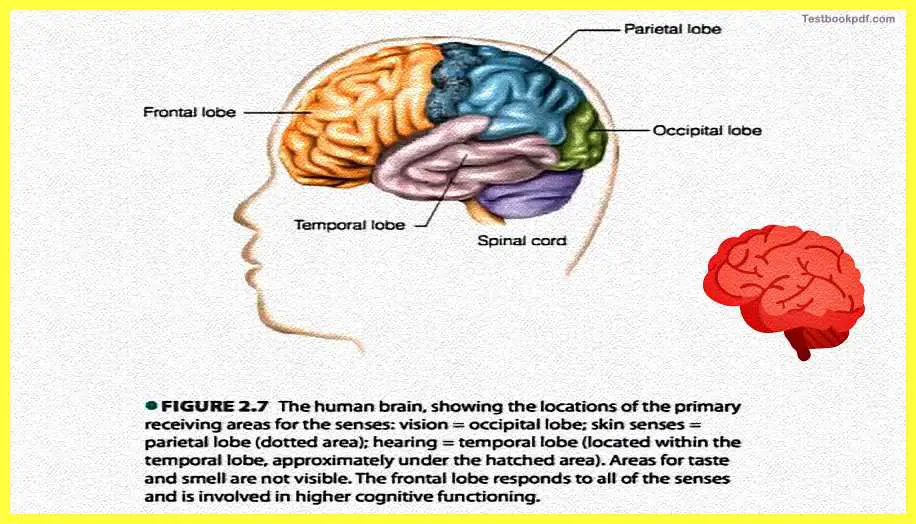
Now here you can see again the frontal lobe the temporal occipital and the parietal lobes in this figure.
Now let us talk about these methods of localization a widely used technique for measuring brain activity in response to this environmental stimulation is the technique of brain imaging basically allows researchers to create images that show which areas of the brain are activated when humans are awake and they are involved in carrying out various cognitive tasks one of those areas I am not really going to do a very exhaustive or an in-detail examination of these things I just actually give you a flavor of what these methods are so that when we are actually talking about experiments using these methodologies while we are doing studying various cognitive functions it kind of gives you a way of understanding what we are talking about.
So the first method we can talk about is positron emission tomography wherein this method is basically one which takes advantage of the fact that blood flow increases towards areas of the brain that are involved or activated by a particular cognitive task say for example there is an area of the brain that is sensitive to viewing faces so every time.
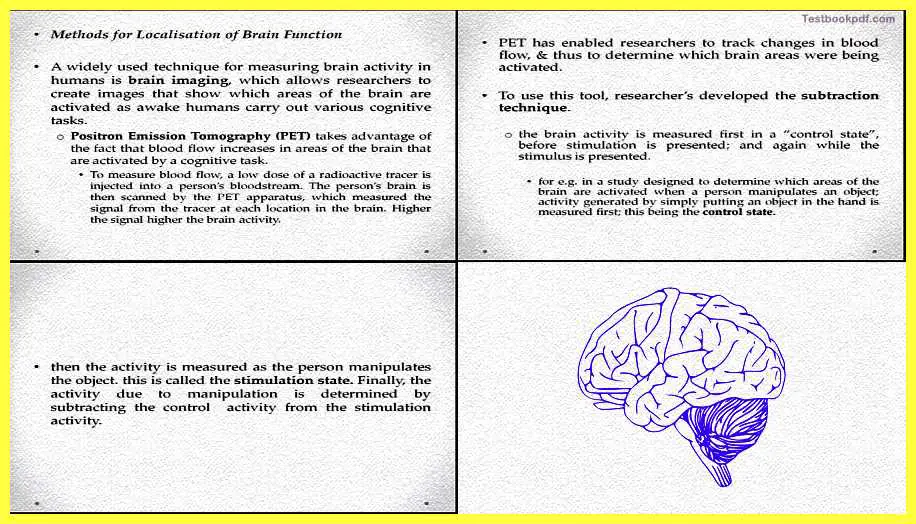
I show you a face in an experimental setup or otherwise, the blood flow to that area of the brain which processes faces will increase a very simple deduction to make so to measure blood flow how do you measure that the blood flow is increasing in that area so what you do is a very low dose of a radioactive tracer is injected into the blood and the person’s brain is then scanned by a p e t expert apparatus wherein a person actually lies down as a big scanner where the person is sent in and then this scanner actually measures the signal from the tracer at each location in the brain higher.
The signal higher the brain activity for example if you are showing me faces and there is an area of the brain that responds selectively to faces I will see the much higher activity of much higher brain activity in that particular area and that can be measured and logged by the scanner now p t basically it has enabled researchers to track changes in blood flow and thus to determine which areas of the brain were being activated this kind of measurement is called functional imaging now how do you really say for example most tasks that we engage in are not very simple tasks.
How do we really do it?
So one of the techniques that researchers have developed to determine this is which areas are specifically involved in which specific cognitive functions are the subtraction technique now this is a rather simple technique what is done is you first measure the brain activity in a control state when the resting say for example kind of a resting state so the person is not doing anything he is just closing his eyes and relaxing and you are measuring where the where this tracer is you just measure the activity of the brain in the resting state I will actually take any let me take an example of a particular study to illustrate what subtraction technique is said, for example, there is a study which was data which was designed to determine which areas of the brain are activated for a person when he manipulates a particular object.
So what they did was they first measured the activity generated by simply putting the object in the person’s hand so the person is just holding the object and you measure the brain activity at that point in time this will be taken as an example of a control state.
Next what you could do is measure the activity when the person is actively manipulating that object it is turning it around say for example if it is a ball or an object is turning object around in the hand and then you again measure the brain activity at that point that is your stimulation state finally what you do is you do this manipulation you subtract the brain activity in this con stimulation state and you subtract the activity of the control state from this activity say for example if the activity.
Let us say i am taking a random number is up to 100 percent in areas x y and c in the stimulation state and the activity in these areas x y and z were just around 40 in the control state this subtraction will give you the number 60 which is pretty much the amount the kind of activation that happened in response to what the person was doing that is manipulating the object this is the simple method of subtraction.
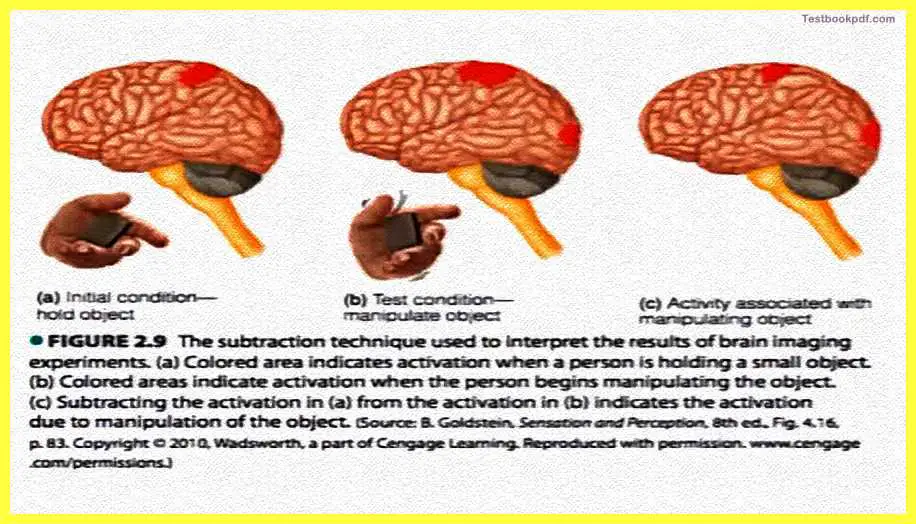
Here you can see this happening in sort of a demonstration so you see on the left most there is an initial condition where the person is just holding the object b is your test condition where the person is actually already manipulating the object and c basically shows you the subtraction so you can see that the areas say for example in the dorsal part of the parietal lobe are basically involved in some sense in the manipulation of the object because that is the part that is left there in the motor areas that is
Functional Magnetic Resonance Imaging (fMRI)
Now another kind of neural imaging technique is called functional magnetic resonance imaging, this was introduced to take advantage of the fact that blood flow can also be measured without injecting any kind of radioactive traces so, for example, some people might be averse and they might be afraid of participating in an experiment which injects a radioactive substance with their blood.
So for the help of those kinds of experiments or dealing with those participants you could have something called functional magnetic resonance imaging now FMRI as it is called as this abbreviation is it uses the fact that hemoglobin which is a molecule in your blood that carries oxygen in the blood and it contains a ferrous molecule something that is attracted to magnets.

It has magnetic properties now if a magnetic field is applied to the brain these hemoglobin molecules start lining up like many tiny magnets they align themselves to the magnetic field that is being applied.
Now FMRI basically indicates the presence of brain activity because hemoglobin molecules in areas of high brain activity lose some of the oxygens they are actually transporting this basically makes the hemoglobin more magnetic so the molecules can then respond more strongly to the magnetic field and you can actually measure that so FMRI operators basically determine the relative activity of various areas of the brain by detecting changes in the magnetic response of hemoglobin.
So if a particular area is involved in crossing a particular kind of stimulus there will be a higher magnetic response coming from those areas so you are actually measuring the amount of magnetic response that is coming from an area if that is more while doing a particular task then that area is involved in doing that task again you can use the logic of the subtraction technique with FMRI as well.
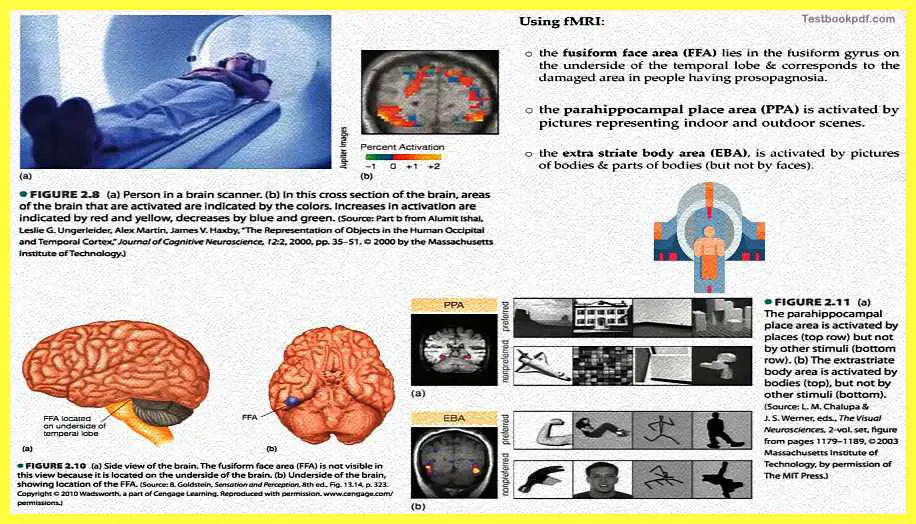
So this is just a prototype of the scanner you can see the person is lying in the scanner and you can see on the right panel that activation is being measured so say for example areas in green are the least acted areas in yellow are more have more activation.
What has fMRI been used for actually localizing a variety of cognitive functions to particular brain areas say for example there is this area called the fusiform face area which lies in the fusiform gyrus on the underside of the temporal lobe and basically corresponds to the damaged area in people having prosopagnosia.
So people who cannot really see faces or recognize faces have damage in this area it is another way of saying that this area is involved in the perception of faces the para hippocampal area basically is activated by looking at pictures of indoor and outdoor scenes similarly the extra straight body area is actually activated by pictures of body parts and parts of bodies but not faces.
Here you can see that in panel a the para hippocampal area place area is being activated by places that are in the top row but not by the body but not by other kinds of stimuli which are in the bottom row in the lower part you can see the EBA getting activated by body parts or body like parts but not in the not by the stimuli which are there in the bottom row so these are some of the ways in which particular areas of the brain have been linked with particular processing of particular kinds of stimuli.
Another technique which is a very interesting technique that we can talk about is the technique of event-related proteins this is basically a sub-part of a broader technique which is electro encephalon encephalography which is basically measuring the electrical activity in the brain now one of the drawbacks with the methods we have been talking about till now FMRI and pt is that they have very good spatial resolution they can actually tell you which area processing is going on but they have a very low temporal resolution they do not tell you at in real time how the processing is happening general kind of reaction time in a pet or an fMRI study is around a few minutes.
ERP System
Now we know that the brain processes stimuli very fast if you really want to know how what kind of mental stages has been gone through while processing a particular stimulus you would want to have a much better temporary solution than temporal resolution is given to us by this technique called ERP which is event-related potentials
What is ERP?
The event-related potential basically is recorded by putting a small disk of electrodes placed on the person’s scalp each electrode picks up signals from the groups of neurons that fire together in the brain under the skull now when say for example the person hears the phrase.
Let us say we have given him to read something like the cat won’t eat and then ERPs are recorded then you can notice that the signals are very rapid because the person is actually reading these stimuli they are reading these words and this is this electrical activity is happening on a scale of milliseconds now because of this very good temporal resolution ERP becomes the ideal technique for investigating processes that are happening in real-time say for example how well or poorly a person is understanding a conversation that is ongoing in which say for example and I to the example of conversation because it is a rather fast process person generally speaks about three words per second in an average way so it is a rather fast process and you are if you want to really understand that you would want to use a method like ERP so this rapid response of ERP.
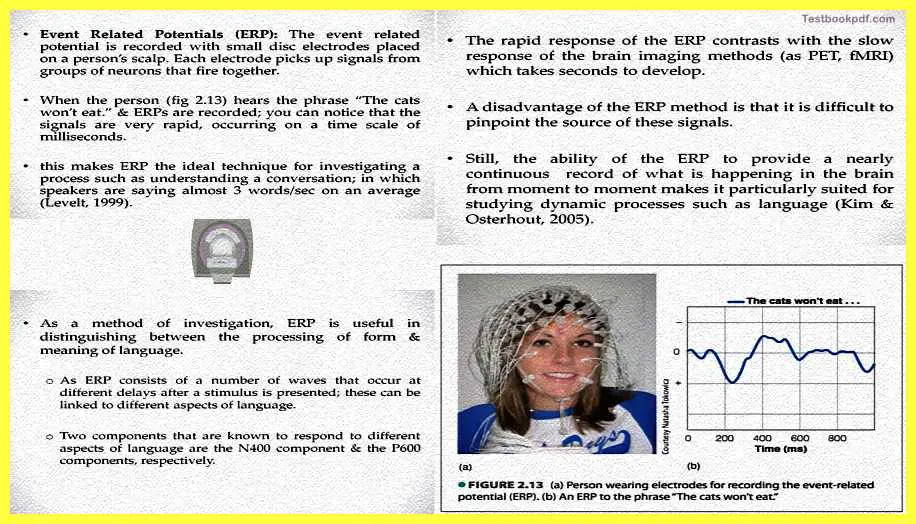
As I said contrasts with the slow response of brain aging methods which we have talked about now one disadvantage of the ERP method by the way is that it is difficult to pinpoint the source of these electric potentials these signals, meanwhile it can tell you at what time what is happening but it cannot really tell you where the signals are sourced from and it is understandable because you cannot really know exactly which set of cells this signal is coming from and there is also the scalp and the hair and everything that the scalp with that is actually underlying these electrodes.
So that is basically something which is very difficult to determine still the ability of ERP to provide a nearly continuous record of what is happening in the brain makes it a very nice method to study say for example dynamic processes as I said language attention those kinds of things let us take an example so as a method of investigation as I said ERP could be very useful say for example in distinguishing how a person is processing the form of language say for example whether it is syntactically correct grammatically correct that is or not or whether it is meaningful or not meaningful.
So as ERP consists of a number of waves that occur at different delays after the stimulus is presented these have been linked these different kinds of waves have been linked to different aspects of language just to take an example the n 400 component which basically is n means negative and 400 means 400 milliseconds so this negative 400 component is actually linked to person processing of meaning if you are processing something which is meaningful which is said for example not meaningful and does not really fit in whatever you have read earlier the n400 component might come up or say for example if you are reading something which is not grammatically correct a p 600 component might come up which is a positive peak of around six hundred milliseconds at around six hundred milliseconds.
So let us face this example here you can see on the left there is a person which having who is having this electrical the scalp or these set of electrodes on her head and she is reading something called reading this fragment of a sentence called the cats wont eat now you see how the brain activity or the electrical activities going on in the brain at this point the person has just read this fragment the cats won’t eat now you actually change this a bit and then you have two kinds of sentences one kind of sentences one kind of sentences basically have a meaning anomaly and the other kind of sentences have a grammatical anomaly so you see cats wont eat and cats wont wake now if you read the cats wont bake they will be a response from the lane which says that cats generally don’t bake so this sentence is non-meaningful in this kind of setup you can see that there is a negative peak you can see on the left panel at around 400 milliseconds so in erp studies generally negative is on the top as you can see from the figure.

So you have you see a peak around 400 milliseconds a negative peak on the right panel you can see the cats won’t eat and cats won’t eating this is just a mistake of grammar in the second sentence so here you can see in the right panel that there is a positive peak which is kind of coming up around 600 milliseconds so in this sense, these two components of ERP tell you how fast and how quickly you are detecting these kinds of anomalies while reading particular sentences.
So this tells you a very important thing that there are different physiological responses to understanding meaning and different physiological responses to understanding the form or the grammatical correctness of any language that you reading it could actually very well be in any language sentences that you might want to use so other sets of experiments have also shown that the n400 is associated with structures in the temporal lobe and damage to areas in the temporal lobe actually reduces the amount of n 400 response that will occur when you come across same sentences like the cats won’t bake.
for example, The cats eat stone or something like that the p 600 response has been associated with structures in the frontal lobe more towards the anterior parts of the brain damage to these kinds of areas in the frontal lobe has been found to reduce the larger p600 responses that occur when the form of the sentence is incorrect so, in that sense, you can actually in some sense estimate that these areas are involved in this kind of processing at that particular time scale nowadays I would like to observe that people are actually doing using a combination of techniques so you can generally see people using a combination of ERP and fMRI wherein they actually get a very good spatial resolution and a very good temporary resolution to go with it now that kind of research designs will also come across when you are actually talking about these different cognitive functions.
Let us sum up what we talked about in today’s article we talked about a variety of ways in which research methodologies have been used to talk about these abstract mental tasks and abstract mental functions which we have been stressing about in the cognitive psychology domain we talked about reaction time task and how the reaction time tasks have been used to investigate different mental functions we talked about neuroimaging tasks like pt and FMRI and we finally talked about electroencephalographic tasks say for example ERPs that is all for today and this was basically about the research methods specific to cognitive psychology thank you.
Read also:
Basics of Research Methodology Psychology Pdf Free Download
The Cerebral Cortex Psychology Theory, Images, Pdf Download
Click here for Complete Psychology Teaching Study Material in Hindi – Lets Learn Squad
